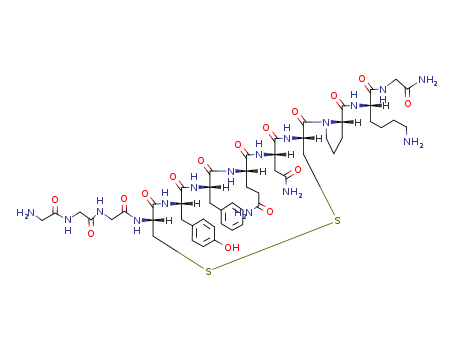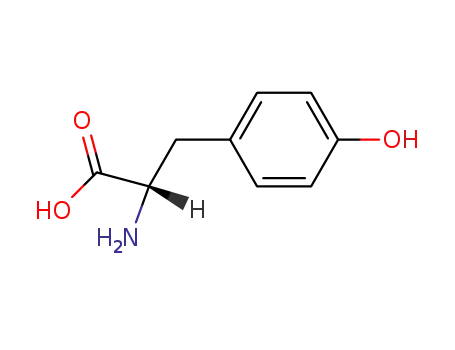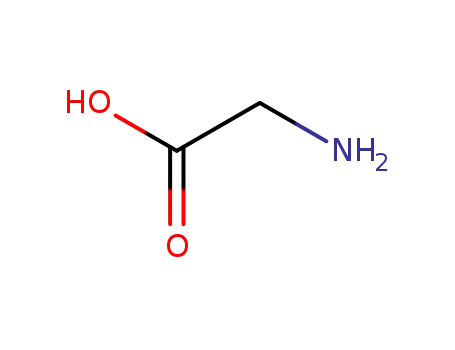- +86 15383000851
- +86 15303238802
- admin@hebeianda.cn
Your Location:Home >Products >API >14636-12-5


Appearance:White powder
Purity:99%
|
Pharmacological effects |
Terlipressin is a novel long-acting synthetic vasopressin reagent,its chemical name is three glycyl lysine vasopressin, it is a prodrug, itself has no activity ,in vivo? , it removes three glycyl residues in its N-terminus by aminopeptidase, and slowly "releases" the active lysine vasopressin. It is this "slow release" mechanism that makes it maintain the smooth muscle contraction up to 10 hours after a single administration, whereas the same dose of vasopressin, it can maintain its activity for 20-40 minutes. On the other hand,because of the slow digestion,? lysine vasopressin in the circulation cannot reach toxic levels, and usage of? terlipressin is safer. Pharmacological effect of terlipressin is splanchnic vascular smooth muscle contraction, and reduction of visceral blood flow (such as reducing blood flow in the mesentery, spleen, uterus, etc.), thereby reducing portal vein blood flow,and reducing portal pressure, on the other hand it may also reduce plasma renin concentration, thereby increasing the renal blood flow in patients with hepatorenal syndrome, to improve kidney function, and increase urine output. Terlipressin is currently the only drug which is able to increase mortality in patients with esophageal varices bleeding , it is previously mainly used in clinical for the treatment of variceal bleeding, in addition,terlipressin now has also been successfully used for liver and kidney integrated syndrome and refractory shock, it is also likely to play a useful role in the cardiopulmonary resuscitation . Compared with vasopressin, it has a lasting effect, and it does not cause dangerous complications, including promoting? fibrinolysis and severe complications in the cardiovascular systems, and the use of it is simple (available intravenous injection), it is more suitable for rescue and treatment of emergent and critical? patients. |
|
Mechanism of Action |
Terlipressin, a synthetic triglycyl-lysine derivative of vasopressin, is a inactive prodrug. It has pressor and antidiuretic effects. Following IV injection, lysine vasopressin are released following the enzymatic cleavage of 3 glycyl moieties. Duration: 4-6 hr. |
|
Adverse Drug Reactions |
Abdominal cramps, cardiac arrhythmias, headache, transient blanching, increased arterial pressure. Potentially Fatal: MI, cardiac failure. |
|
Description |
Terlipressin acetate is a novel synthetic long-acting vasopressin preparation. It is a kind of prodrug, which is inactive by itself. After the action of aminopeptidase in the body, after removing the three glycyl residues at its N-terminus, it slowly "releases" the active lysine vasopressin. Therefore, terlipressin acts as a reservoir that releases lysine vasopressin at a steady rate. |
|
Chemical Properties |
N-(N-(N-Glycylglycyl)glycyl)-8-L-lysinevasopressin is White Solid |
|
Uses |
N-(N-(N-Glycylglycyl)glycyl)-8-L-lysinevasopressin is an analogue of vasopressin used as a vasoactive drug in the management of hypotension. N-(N-(N-Glycylglycyl)glycyl)-8-L-lysinevasopressin is used norepinephrine-resistant septic shock and hepatorenal syndrome. N-(N-(N-Glycylglycyl)glycyl)-8-L-lysinevasopressin is also used in the treatment of acute variceal bleeding. Treatment of bleeding oesophageal varices |
|
Drug interactions |
Potentially hazardous interactions with other drugs None known |
|
Metabolism |
Terlipressin is metabolised by tissue peptidases resulting in the slow release of lypressin. Terlipressin is almost completely metabolised in the kidneys and liver, with less than 1% of terlipressin and less than 0.1% of lypressin excreted in the urine. |
InChI:InChI=1/C52H74N16O15S2/c53-17-5-4-9-31(45(76)60-23-41(57)72)63-51(82)38-10-6-18-68(38)52(83)37-27-85-84-26-36(61-44(75)25-59-43(74)24-58-42(73)22-54)50(81)65-34(20-29-11-13-30(69)14-12-29)48(79)64-33(19-28-7-2-1-3-8-28)47(78)62-32(15-16-39(55)70)46(77)66-35(21-40(56)71)49(80)67-37/h1-3,7-8,11-14,31-38,69H,4-6,9-10,15-27,53-54H2,(H2,55,70)(H2,56,71)(H2,57,72)(H,58,73)(H,59,74)(H,60,76)(H,61,75)(H,62,78)(H,63,82)(H,64,79)(H,65,81)(H,66,77)(H,67,80)/t31-,32-,33-,34-,35-,36-,37-,38-/m0/s1

L-phenylalanine

L-tyrosine

glycine
CAS:868844-74-0
CAS:52-90-4
CAS:1202044-20-9
CAS:100-09-4